Ajloun Castle
Ajloun Castle (Arabic: قلعة عجلون; transliterated: Qalʻat 'Ajloun), is a 12th-century Muslim castle situated in northwestern Jordan. It is placed on a hilltop belonging to the Mount Ajloun district, also known as Jabal 'Auf after a Bedouin tribe which had captured the area in the 12th century. From its high ground the castle was guarding three wadis which descend towards the Jordan Valley. It was built by the Ayyubids in the 12th century and enlarged by the Mamluks in the 13th.
| Ajloun Castle قلعة عجلون | |
|---|---|
| Ajloun, Jordan | |
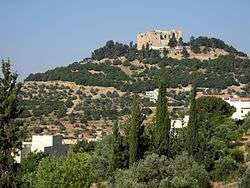 Ajloun Castle | |
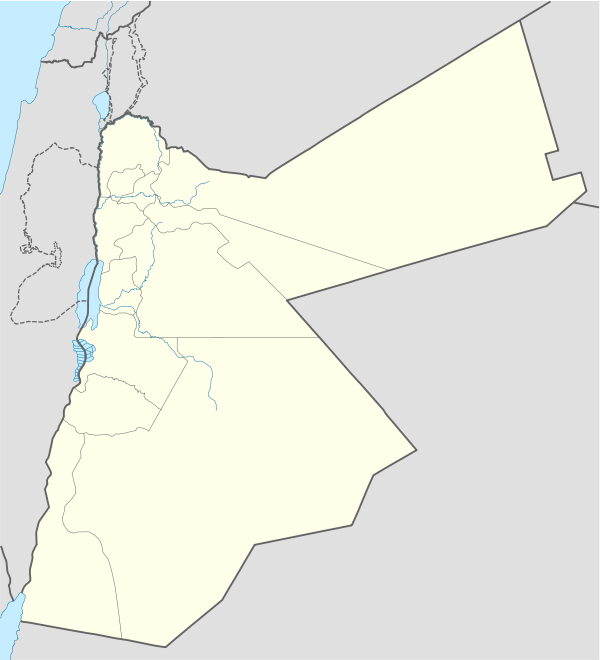 Ajloun Castle قلعة عجلون | |
| Coordinates | 32°19′30.75″N 35°43′38.21″E |
| Type | Castle |
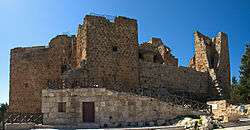
The name 'Ajlun goes back to a Christian monk who lived on this mountain in the Byzantine period.[1] The castle stands on the ruins of a monastery, traces of which were discovered during archaeological excavations.
The castle has been the nucleus of a settlement which has grown to become the present town of Ajloun. The castle's developing faubourg led to its second name, Qalʻat ar-Rabad, "the castle of the faubourg" or "the castle with the suburbs”.
History
Ajlun Castle is located on the site of an old monastery. It was renovated as a fort in 1184 by Izz al-Din Usama, a general in the army of Saladin. The castle controlled traffic along the road connecting Damascus and Egypt.[2] According to Saladin's historian Baha ad-Din ibn Shaddad, the fortress was primarily built in order to help the authorities in Damascus control the Bedouin tribes of the Jabal 'Auf. These enjoyed enough autonomy as to ally themselves to the Crusaders, and had at one point set up a 100-tent camp next to the Hospitaller castle of Belvoir on the opposite side of the Jordan Valley.[3] As such, Ajlun Castle is one of the very few Muslim fortresses built by the Ayyubids to protect their realm against Crusader incursions, which could come from Beisan or Belvoir in the west and from Karak in the south.
From its location, the fortress dominated a wide stretch of the northern Jordan Valley, controlled the three main passages that led to it (Wadi Kufranjah, Wadi Rajeb and Wadi al-Yabis), and protected the communication routes between southern Jordan and Syria. It was built to contain the progress of the Latin Kingdom, which with the Lordship of Oultrejourdain had gained a foothold in Transjordan, and as a retort to the castle of Belvoir a few miles south of the Sea of Galilee. Another major objective of the fortress was to protect the development and control of the iron mines of Ajlun.
Initial building
The original castle had four corner towers connected by curtain walls and a double gate. Arrow slits were incorporated in the thick walls and it was surrounded by a moat averaging 16 meters (about 52 feet) in width and 12–15 meters (about 40–50 feet) in depth.
Expansion
After Usama's death, the castle was enlarged in AD 1214–15 by Aibak ibn Abdullah, the Mamluk governor. He added a new tower in the southeast corner and built the gate.
The castle lost its military importance after the fall of Karak in AD 1187 to the Ayyubids. In the middle of the 13th century AD, the castle was conceded to Yousef ibn Ayoub, King of Aleppo and Damascus, who restored the northeastern tower and used the castle as an administrative center.
In 1260 AD, the Mongols destroyed sections of the castle, including its battlements. Soon after the victory of the Mamluks over the Mongols at Ain Jalut, Sultan ad-Dhaher Baibars restored the castle and cleared the fosse. The castle was used as a storehouse for crops and provisions. When Izz ad-Din Aibak was appointed governor, he renovated the castle as indicated by an inscription found in the castle's south-western tower.
During the Ottoman period, a contingent of fifty soldiers was set inside the castle. During the first quarter of the 17th century, Prince Fakhr ad-Din al-Ma'ni II used it during his fight against Ahmad ibn Tarbay. He supplied the castle with a contingent and provided provisions and ammunition. In 1812, the Swiss traveller Johann Ludwig Burckhardt found the castle inhabited by around forty people.
Two major destructive earthquakes struck the castle in 1837 and 1927. Recently, the Department of Antiquities of Jordan has sponsored a program of restoration and consolidation of the walls and has rebuilt the bridge over the fosse.
Tourism

Ajlun castle is open for tourism. Many areas of the castle can be explored. Tourists in Jordan often visit the castle. Inside there is also a museum exhibition with many interesting artifacts from the various time periods of the region.
Gallery
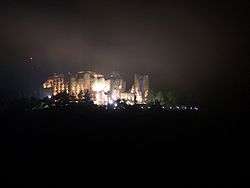 View at night
View at night Inner view
Inner view A room
A room One of the watchtowers
One of the watchtowers Roof
Roof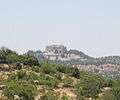 Auf Mountain
Auf Mountain Castle walls
Castle walls
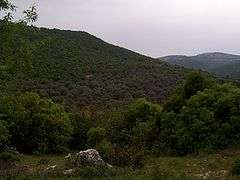 Ajloun Mountains
Ajloun Mountains Ajloun Castle Museum
Ajloun Castle Museum Ajloun Castle Museum
Ajloun Castle Museum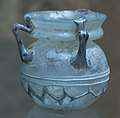 Ajloun Castle Museum
Ajloun Castle Museum Ajloun Castle Museum
Ajloun Castle Museum Ajloun Castle Museum
Ajloun Castle Museum Carved door from Ajloun Castle Museum Collection
Carved door from Ajloun Castle Museum Collection Preserved mosaic floor from Ajloun Castle
Preserved mosaic floor from Ajloun Castle.jpg) Bridge
Bridge.jpg) Close-up of Entrance
Close-up of Entrance.jpg) Alternative distance view of the castle atop Jabal 'Auf.
Alternative distance view of the castle atop Jabal 'Auf..jpg) Inner view of the castle
Inner view of the castle
References
- Maurice Gaudefroy-Demombynes, La Syrie à l'époque des Mamelouks d'après les auteurs arabes, Bibliothèque archéologique et historique du Service des Antiquités et des Beaux-Arts en Syrie et au Liban, vol. III, Paris 1923, p 66
- Teller, Matthew (2002). Jordan. Rough Guides. p. 173. ISBN 9781858287409.
Ajloun earthquake damage.
- Joseph M. Delaville Le Roulx, Cartulaire général de l'ordre des Hospitaliers de Saint-Jean de Jérusalem (1100-1301), vol. I, Paris 1894, p 395-396, No. 582 of 28 April 1180
Bibliography
- Darwish, Nazmieh Rida Tawfiq (1990). Jordan. Plurigraf Narni.
External links
| Wikimedia Commons has media related to Ajlun Castle. |
